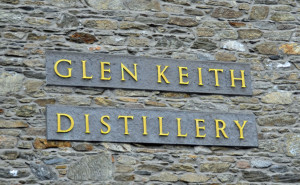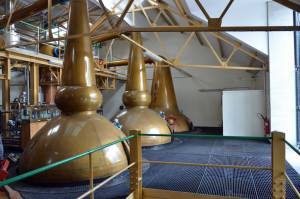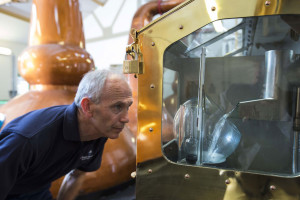In Depth On Glen Keith
Inside One Of Scotland’s Most Modern Distilleries
By Richard Thomas

(Credit: Richard Thomas)
Visitors to Scotland’s Speyside whisky region are often eager to see two things: the striking Scottish landscape and distilleries. So it was with a pair of American gentlemen I saw there last week during the Spirit of Speyside Festival, posing for pictures outside the doorstep of the Glen Keith.
Standing at the door was all they could do, however, because Glen Keith, one of the industry’s most modern distilleries, is closed to visitors. They could content themselves with the contrast of Strathsisla, located just across the namesake river Isla and the oldest continually operating distillery in Scotland, but what they really wanted a peek inside this distillery. So I guessed from the envious look I glanced as I was led into Glen Keith through a side door.

(Credit: Richard Thomas)
Sixty Years Young
Calling Glen Keith one of Scotland’s most modern distilleries is a statement with a double meaning, because the very history of Glen Keith is so recent. The distillery began production in 1958, and at that time was the first new distillery to open in Scotland in six decades.
Moreover, Glen Keith opened as something of an oddity. Then as now, the main target for Glen Keith’s output was the American market, which at the time meant making light, easy-going whiskies. So, the distillery borrowed a page from Ireland and installed three stills for triple distillation. This was not unheard of at the time, although in the scotch industry double distillation is the norm. This Irish style was eventually abandoned during a 1970s expansion, and the distillery switched to double distillation. Owned by Chivas Brothers, most of the distillery’s output was (and is) destined for blends such as Chivas Regal, 100 Pipers and Passport.
Glen Keith was mothballed by Chivas Brothers in 1999, the same year that scotch whisky began to see steady annual sales growth. A decade later and that stable, long-term rise was starting to cause supply difficulties for some companies in the Scotch industry, prompting the Chivas to bring the distillery back in 2012.
More Reconstruction Than Renovation

(Credit: Chivas Brothers)
The problem confronting Chivas Brothers when they decided to reopen Glen Keith was that restarting the distillery was not as simple as cleaning up and turning a few switches. During the 13 years spent in mothball, Glen Keith was extensively cannibalized for spare parts to service other distilleries. Reopening the facility in 2013 was a matter of building a new plant inside the old buildings.
The six old pot stills remained and these were refurbished, but almost everything else is new: malt storage, mash tun, most of the washbacks, and much else besides. Glen Keith’s cask-filling house is shared with neighboring Strathsisla. The latest sustainable energy technology was installed, recycling heat from the stills and reducing energy costs by 15% compared to the next most efficient distillery owned by the company. The production capacity has almost doubled over the old Glen Keith, to six million liters of new make whisky per year.
Brand Shiny New
So behind its grey stone, castle-like walls, Glen Keith is a sparklingly new facility. Indeed, the only working distillery I’ve seen that looks more modern than Glen Keith is Tullamore Dew, which opened last year.
In being so contemporary, some of the romance of distilling is lost. Such a place looks exactly like what it is: a computerized, efficient factory for making whisky. Those two fellow Americans I left behind at the front door probably would have been disappointed had they gotten their peek, since that isn’t what most whiskey tourists travel to see.
Even so, I feel the picturesque village of Keith is missing out on something while Glen Keith is closed to the public. As I implied before, what an excellent, convenient contrast it makes to have what is arguably Scotland’s most historic distillery just a few minutes walk away from one of its most up-to-date.



